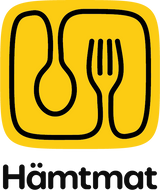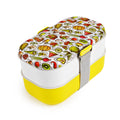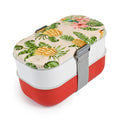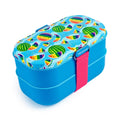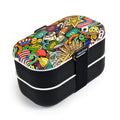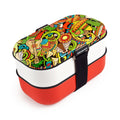Office menu: seven nutrition rules for those who are always at work, but want to keep fit

Modern human life is becoming increasingly complex and challenging due to the constant barrage of temptations that surround us. In the past, we had to physically hunt for our food and cultivate our gardens to meet our basic needs. Now, with the advent of technology and the internet, we can easily order any food we desire with just a few clicks on our computer or phone. Restaurants are constantly updating their menus with new and tempting options, and it seems like everywhere we turn, sweet treats and delicious snacks are being offered to us.
However, along with these food temptations, people have come to realize that the quality of the products we consume is perhaps the most important factor in maintaining our overall health. The challenge is not in obtaining food, but in learning how to eat healthily and moderately in a world that is filled with deadlines, sedentary work, and easily accessible, but often unhealthy, food options.
This article aims to provide helpful information on how many times a day we should be eating, what a healthy snack should consist of, what options to choose at a restaurant during a business lunch and what to eat after a workout. By understanding the importance of making healthy food choices, we can learn to navigate the complex world of food temptations and maintain a healthy and balanced lifestyle.

It includes the following:
1. No Temptations: eat five meals a day
2. Difference between healthy and unhealthy snacks
3. Calories and Grams of the snack
4. What to order at a business lunch?
5. Packing a healthy lunchbox
6. The importance of water
7. Cup of vigor: how much coffee you can drink
1. No Temptations: Eat five meals a day
For office workers, maintaining a healthy and balanced diet can be a challenge, especially if their work involves long hours of sitting and performing routine tasks. One common problem faced by office employees is the constant desire to snack, which can lead to overeating and weight gain. To combat this, it is recommended to adopt a 5-meal eating schedule. This schedule includes having a nutritious breakfast at home, followed by a mid-morning snack such as a piece of fruit, dried fruit, or a small piece of chocolate, to be consumed at work. Lunch should be taken at the usual time, and then a healthy snack such as a handful of nuts or a protein bar should be consumed three hours later. Dinner should be taken at home.
Long breaks between meals may not cause hunger, but when there are sweets, sugary coffee, and other unhealthy snacks constantly available in the office, the temptation to indulge in them can be very strong. Eating a healthy snack every 2-3 hours can help to reduce the temptation to snack on unhealthy foods. This schedule not only helps to control hunger and cravings but also ensures that you are consuming a balanced and nutritious diet throughout the day.
In addition, it is also important to be mindful of the types of food and drinks consumed during office hours. Opting for healthier options, such as fruits, nuts, protein bars, and avoiding processed snacks, sugary drinks, and excessive caffeine can help to prevent weight gain and promote overall health.

2. Difference between healthy and unhealthy snacks
Unhealthy snacks are foods that are high in added sugars, saturated fats, and processed ingredients. These types of snacks, such as processed cookies, cakes, chips, and candy, provide little to no nutritional value and can contribute to weight gain and chronic health conditions such as obesity, diabetes, and heart disease. They are often high in calories and low in essential nutrients, such as vitamins and minerals that are needed for the body to function properly.
Eating these types of snacks can also lead to blood sugar spikes and crashes, which can cause feelings of fatigue and irritability. Additionally, consuming a diet high in processed foods and added sugars can increase inflammation in the body, which has been linked to a variety of chronic health conditions such as cancer, heart disease, and neurological disorders. Furthermore, many unhealthy snacks are high in sodium, which can lead to high blood pressure, kidney disease, and heart disease. They also contain artificial flavors, colors, and preservatives that can be harmful to our bodies.
Unhealthy snacks can be detrimental to our overall health and well-being and should be avoided as much as possible. It is essential to choose the right snacks, which will help you to keep fit.
Healthy snacks must be nutritious, and easy to eat on the go. Some great snack options include any type of fresh fruit, dried fruit, marshmallows, flax chips, veggie snacks with hummus, a piece of dark chocolate, and protein or cereal bars. When choosing protein or cereal bars, it is important to look for options that are made with natural sweeteners such as honey, maple syrup, coconut sugar, or dates. These sweeteners are healthier alternatives to refined sugar and can help to reduce the risk of developing chronic diseases such as diabetes and heart disease.

3. Calories and Grams of the snack
When it comes to snacking, it is important to keep portion sizes in mind. A snack should be considered a small portion of food, and should not be equivalent to a full meal. For example, a plate of pasta or a cutlet with salad cannot be considered a snack, as these are complete meals. The optimal formula for a snack serving size is 150-200 calories or 1/3 of the calorie content of the main meal or 1/3 of the volume of the total serving.
When considering the serving size in grams, the main portions should be in the range of 250-450 grams (taking into account factors such as gender, age, and weight). A snack should be in the range of 20-200 grams, depending on the product: for example, 1 fruit, half a glass of yogurt, 1 bar, 20 grams of nuts, or bread with a piece of cheese.
It is also important to consider the calorie content of the foods we consume. For example, 100 grams of nuts contain almost 700 calories. Therefore, consuming 20 grams of nuts as a snack can be beneficial, but consuming 100 grams would no longer be considered a healthy snack option.
By keeping portion sizes and calorie content in mind, we can make healthier snack choices that will benefit our overall health and well-being. It is important to choose a variety of healthy snacks and not overdo any one snack. This way we can maintain a balanced diet and prevent weight gain.

4. What to order at a business lunch?
When dining at a cafe or restaurant, it's important to make smart choices about what to order to maintain a healthy diet. To do this, you should try to avoid dishes that are high in butter and white rice, as well as those that come with fatty broth. Instead, opt for dishes that are made with fresh vegetables and lean meats, such as stewed vegetables and steamed cutlets, or a vegetable soup.
Another great option when dining out is to choose salad over soup. Salads made with fresh vegetables such as cabbage, carrots, and boiled beets are a great way to get your daily dose of vitamins and nutrients, while also being low in calories. You can also add a side dish to your salad, such as porridge, durum wheat pasta, or a slice of dark bread. To make your meal even more complete, be sure to add a piece of meat, fish, an omelet, or bean stew.
On the other hand, if you choose to indulge in a heavy meal that is high in butter, mayonnaise, fatty meats, potatoes, and white bread, you may find that you feel tired and sluggish after dinner, and your productivity may decrease. To maintain optimal health, it's important to make smart choices about what you eat and to limit your intake of high-calorie, high-fat foods.

5. Packing a healthy lunchbox
Bringing food to work is ideal. Therefore, you will know exactly what you put in a lunchbox, and you will be able to calculate the calories and the content of nutrients.
Choose lunch bento boxes with dividers inside; food always stays fresh in them. Half of the serving should be occupied by vegetables, in the second place is a protein (meat/fish) and in the third - pasta/bread or porridge.
Lunch should be the highest-calorie meal of the day and the largest in volume. However, if you choose a heavy meal - with butter, mayonnaise, fatty meats, potatoes, and white bread - you will want to take a nap after dinner, and your productivity will decrease. Therefore, for the second half of the day to pass on a high note, choose the right products.
Perfect choice for lunch:
1. Garnish: durum wheat pasta, dark rice, buckwheat porridge, bulgur, or a slice of bread.
2. Necessarily vegetables: fresh, stewed, grilled. Take the salad not seasoned, otherwise, it drains.
3. A piece of meat or fish, seafood or cheese.
These products are packed with nutrients and will provide you with the energy you need for the day.

The best lunchbox should have the following qualities:
• Insulation to keep food at the proper temperature
• Durable and easy-to-clean material
• Compartments or dividers to keep food separate
• Leak-proof design to prevent spills
• Lightweight and easy to carry
• Aesthetically pleasing design
• BPA-free and non-toxic material
• Large enough to hold a sufficient amount of food
• Easy to open and close
• Eco-friendly and reusable
Hämtmat lunchboxes are the ideal option for those looking for a functional and stylish way to carry their food. With two series of options available in bright colors and unique designs, Hämtmat offers a variety of options to suit any taste. Not only are they comfortable and functional, but they are also compact and visually pleasing. Hämtmat lunchboxes are not just a convenient container for food, but also a way to express your style and values through a small everyday item. Let your Hämtmat lunchbox bring a touch of color and creativity to your workday.

6. The importance of water
When it comes to staying hydrated, it's important to know the recommended amount of water to drink based on your body weight. It is suggested to consume 30-40 ml of water per 1 kg of body weight. However, this amount increases when engaging in sports and other physical activities. The average minimum requirement for an adult is 1.5 liters of water per day. It is important to note that it may take a few weeks to get used to drinking this much water regularly and to "train" your body to recognize thirst.
To make sure that you are consistently staying hydrated, there are several ways to remind yourself to drink water. One option is to set reminders on your phone, whether it be through an alarm clock or calendar reminder. Another option is to use a water-tracking app to monitor your water intake throughout the day. Additionally, you can place a half-liter glass on your desk and make sure you drink at least three glasses of water by the end of the day. It's important to find a method that works for you and make sure that you are drinking enough water to stay healthy.

7. Cup of vigor: how much coffee you can drink
Coffee is a beloved beverage consumed by many people around the world. It is a great source of caffeine, which can help boost energy levels and improve concentration. However, it is important to consume coffee in moderation to avoid any negative side effects. A safe and recommended daily intake of coffee is up to 2 cups, consumed without or with a minimal amount of milk, and without sugar.
It is important to note that when consuming coffee, it is best to choose plain coffee over coffee drinks such as lattes, cappuccinos, and other similar beverages. This is especially important for those who are trying to lose weight as these drinks often contain added sugar and calories.
If you find it difficult to drink pure Americano, there are alternative options available. Plant-based kinds of milk such as soy, almond, and coconut can be used to make coffee drinks and offer a creamy taste without the lactose found in dairy milk. These options can be a great alternative for those who are lactose intolerant or are looking for a healthier option.
For those who are looking to wake up and improve focus, green tea can be a great alternative to coffee. It contains caffeine but also has other compounds that can help improve focus and alertness. Overall, it is important to pay attention to the amount of coffee and the way you drink it, to make sure you get the best benefits without a negative impact on your health.

Conclusion:
In conclusion, it's essential to make an effort to stay healthy and eat right at work. It's not always easy, but with a little planning and preparation, it can be done. We hope that the seven tips provided in this article will help you make the most of your workday and keep your body in optimal condition. Remember that taking care of your health is an act of self-love, and it is important to prioritize it to maintain energy and overall wellness. Eating healthy cannot only benefit your physical health but also your mental well-being and productivity.
TAGS:
SHARE:


